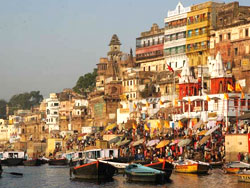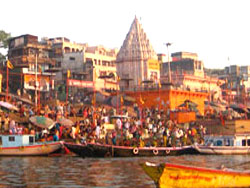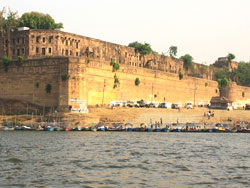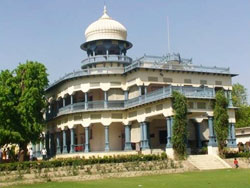
इलाहाबाद एक ऐसा शहर है जिसे (दो या अधिक नदियों का पवित्र संगम) गंगा और यमुना नदियों के संगम द्वारा परिभाषित किया गया है। किंवदंती के अनुसार, एक तीसरी नदी, पौराणिक सरस्वती को भी दो नदियों में शामिल होना माना जाता है, जिससे संगम या संगम को एक पवित्र आयाम दिया जाता है, जो आत्मा-सफाई शक्तियों से परिपूर्ण होता है। कहा जाता है कि ब्रह्मा ने तीर्थ राज, या 'तीर्थ स्थान का राजा' कहा है। पवित्र संगम हर समय तीर्थयात्रियों को आकर्षित करती है, लेकिन विशेष रूप से महाकुंभ मेले के समय, एक जबड़ा छोड़ने वाला तमाशा जब लाखों भक्त पुनर्जन्म के अनन्त चक्र को तोड़ने के लिए पानी में विनम्रता से स्नान करते हैं। अधिक सांसारिक स्तर पर, इलाहाबाद एक ब्रिटिश औपनिवेशिक समझौता और पंडित जवाहरलाल नेहरू के परिवार के घर थे, जिनकी बेटी ने भारत के शक्तिशाली नेहरू-गांधी राजनीतिक वंश को मिला।
इलाहाबाद इतिहास
इलाहाबाद प्राचीन काल में प्रयाग के रूप में जाना जाता था, और भगवान ब्रह्मा ने वहां एक बलिदान किया था। चीनी तीर्थयात्री जूआन झांग (हेन त्सांग) ने 634 ईस्वी में शहर का दौरा किया। इलाहाबाद ने अपना वर्तमान नाम मुगलों से प्राप्त किया, जिन्होंने इसका नाम इलाहाबाद रखा, या भगवान का स्थान मुगल सम्राट अकबर ने 1583 में एक किले का निर्माण किया था, जो कि गंगा और यमुना के बीच घाटी में फैला था, रणनीतिक महत्व का एक क्षेत्र। 1615 में सम्राट शाहजहां ने उनके भाई खुसरू की हत्या कर दी थी, ताकि उनके सिंहासन में प्रवेश हो सके। बाद में शहर मराठों द्वारा उठाए गए, पठानों द्वारा बर्खास्त हुए, और अंत में अवद के नवाब ने 1801 में अंग्रेजों को सौंप दिया। उसके बाद, शहर ब्रिटिश सैन्य छावनी बन गया भारतीय स्वतंत्रता के पहले युद्ध के बाद 1857 में भारतीय स्वतंत्रता के पहले युद्ध, अंग्रेजों ने आगरा से उत्तर पश्चिमी प्रांत का मुख्यालय चले। इलाहाबाद ने ईस्ट इंडिया कंपनी से औपचारिक रूप से 1858 में क्राउन तक का हस्तांतरण देखा, जिसे तत्कालीन वाइसराय लॉर्ड कैनिंग ने घोषित किया था। राष्ट्रीय स्वतंत्रता के लिए लड़ाई में शहर ने भी महत्वपूर्ण भूमिका निभाई। यह 1885 में भारतीय राष्ट्रीय कांग्रेस की पहली बैठक देखी गई। इलाहाबाद भी है जहां महात्मा गांधी की अहिंसक स्वतंत्रता आंदोलन का उद्घाटन किया गया। हालांकि, स्वतंत्रता आंदोलन के साथ शहर का सबसे मजबूत संबंध इस तथ्य से उभरता है कि यह पंडित जवाहरलाल नेहरू, भारत के पहले प्रधान मंत्री और उनके पिता मोतीलाल नेहरू का गृहनगर था, जिन्होंने स्वतंत्रता संग्राम में भी भूमिका निभाई थी। नेहरू नेहरू-गांधी वंश के लिए नींव रखे जाने पर, एक ऐसा परिवार जो आजादी के बाद भारत की राजनीतिक जिंदगी पर हावी होगा।
स्थान
इलाहाबाद उत्तर प्रदेश राज्य में स्थित है और वाराणसी से 125 किमी दूर है। यह गंगा और यमुना नदियों के संगम पर स्थित है। इस शहर को रेलवे लाइन द्वारा इसके माध्यम से चलने से विभाजित किया गया है। पटरियों के दक्षिण में पुराना चौक क्षेत्र है, जबकि ब्रिटिश निर्मित सिविल लाइन्स उत्तर में स्थित है, इसके साथ ही ग्रिड में अपनी सारी गलियों को रखा गया है। यमुना नदी इलाहाबाद के दक्षिण में बहती है, जब तक यह शहर के दक्षिण-पूर्वी छोर पर संगम बिंदु तक नहीं पहुंचता है। गंगा अपने पूर्वी किनारे पर बहती है ग्रांड ट्रंक रोड भी चौक के केंद्र के माध्यम से, शहर के माध्यम से चला जाता है। त्रिवेणी सड़क ग्रांड ट्रंक रोड से संगम तक जाता है।
कैसे पहुंचा जाये
वायु: निकटतम हवाई अड्डा वाराणसी (125 किमी) है, जो आगरा, भुवनेश्वर, मुंबई, दिल्ली, खजुराहो और लखनऊ के शहरों से जुड़ा है।
रेलवे: इलाहाबाद एक महत्वपूर्ण रेल टर्मिनस है, जिसमें आगरा, दिल्ली, गोरखपुर, ग्वालियर, कानपुर और लखनऊ सहित भारत के सभी प्रमुख शहरों के साथ रेल से जुड़ा है।
रोड: इलाहाबाद से महत्वपूर्ण सड़क की दूरी: आगरा (483 किमी), दिल्ली (612 किमी), लखनऊ (227 किमी), लुम्बिनी (406 किमी), खजुराहो (2 9 4 किमी), वाराणसी (125 किमी), चित्रकूट (128 किमी) (1 9 7 किमी), कानपुर (1 9 8 किमी), नागपुर (618 किमी), उदयपुर (9 56 किमी), इतावा, कोलकाता (79 9 किमी), झांसी (375 किमी), तिरुवनंतपुरम (2,413 किमी), अहमददद (1,207 किमी) (331 किमी), पटना (368 किमी), भोपाल (680 किमी), जयपुर (673 किमी), मुंबई (1,444 किमी) इलाहाबाद से चित्रकूट, अयोध्या, वाराणसी, लखनऊ और कानपुर से भी सीधी बस सेवाएं हैं।
यात्रा की जगहें
संगम
गंगा और यमुना नदी के संगम (या संगम जो इलाहाबाद को हिंदुओं के लिए एक पवित्र स्थान बनाता है।) प्रबुद्धता की पौराणिक नदी सरस्वती, माना जाता है। यह माना जाता है कि एक पवित्र नदी की पवित्र शक्ति संगम पर मजबूत बनाया.यह संगम महान आत्मा-शुद्ध करने की शक्ति देता है, और सभी हिंदुओं को अपने जीवनकाल में कम से कम एक बार स्नान करने की आशा है, ताकि वे अपने पापों को दूर कर सकें।
सिविल लाइन्स से लगभग 7 किमी दूर, इलाहाबाद के किले के पूर्वी किनारे, व्यापक बाढ़ के मैदानों और गंदी बैंकों द्वारा अनगिनत पवित्र संगम की ओर निकल जाता है। जिस बिंदु पर भूरे रंग का गंगा हरियाली यमुना से मिलता है, पूजा करने के लिए छोटे प्लेटफार्मों पर याजकों की पर्चिंग होती है और उथले पानी में अपने अनुष्ठानों में धर्मार्थ की सहायता करती है। समुद्र तटों और घाटियों को तीर्थयात्रियों के बालों से भरे हुए हैं जो उनके माता-पिता के लिए पिंड (प्रसाद) की पेशकश करते हैं।
संगम के लिए नाव, जो कि तीर्थयात्रियों और पर्यटकों द्वारा समान रूप से उपयोग किया जाता है, उन्हें घाट पर किराए पर लिया जा सकता है (कि तत्काल पानी के लिए कदम उठाने वाले) किले की पूर्व में 12 रुपये प्रति व्यक्ति की सिफारिश की सरकार की दर।
हालांकि, अधिकांश तीर्थयात्रियों ने 36 रुपये का भुगतान किया है और आप पर 150 रुपये तक का आरोप लगाया जा सकता है। पूरे नाव की आधिकारिक कीमतें 100 रुपये और 120 रुपये के बीच हैं, लेकिन पीक सीज़न में 250 रुपये से ज्यादा की बढ़ोतरी कर सकते हैं।
इलाहाबाद किला
1583 ईस्वी में सम्राट अकबर द्वारा निर्मित विशाल किला संगम स्थल के पास यमुना के किनारे पर स्थित है। किले में बड़ी दीवारें हैं और तीन द्वार उच्च टावरों की ओर झुकते हैं। वर्तमान में यह सेना द्वारा उपयोग किया जाता है, इसलिए केवल एक सीमित क्षेत्र आगंतुकों के लिए खुला है। बाहरी दीवार बरकरार है और पानी के किनारे के ऊपर उगता है किले जब नदी से देखा जाता है, तो प्रभावशाली होता है, ताकि आप इसे देखने के लिए संगम से नाव ले सकते हैं या किनारे की दक्षिणी दीवार की स्कर्ट नदी के किनारे पर चल सकते हैं। आगंतुकों को किले का दौरा करने की अनुमति है, जो कि कमांडेंट, ऑर्डिनेंस डिपो, फोर्ट, इलाहाबाद से प्राप्त की जा सकती है। टेलीफोन: 6064738, एक्सटेंशन 213 एक बार किले के अंदर, अशोक स्तंभ को देखें जो कि पूर्वी 232 ईसा पूर्व है। किले की पूर्वी दीवार में एक छोटा सा दरवाजा भूमिगत पातालपुरी मंदिर की ओर जाता है जो अनन्त बरगद के पेड़ पर रहता है, जिसे अक्षय वेता भी कहा जाता है। इस पेड़ का वर्णन जुआन झांग (हेन त्सांग) द्वारा किया गया है, जो तीर्थयात्रियों को उद्धार प्राप्त करने के लिए अपनी मृत्यु से छलांग के साथ अपनी जिंदगी का त्याग करते हैं। इसमें अभी तक बहुत कुछ नहीं बचा है, यद्यपि।
हनुमान मंदिर
इलाहाबाद के किले के निकट, यह मंदिर हनुमान की झुकने वाली छवि से अलग है। यह कहा जाता है कि हर साल बाढ़ के दौरान, गंगा का पानी मस्तिष्क के पैरों को पीछे होने से पहले स्पर्श करने के लिए उगता है।
सरस्वती घाट
सरस्वती घाट संगम के करीब है और भक्तों के साथ एक लोकप्रिय स्थान भी है। महिलाओं को फ्लोटिंग डाईज, या छोटे तेल की दीपक नीचे की ओर से आरती या शाम की पूजा करते हैं।
खुसरू बाग
इलाहाबाद जंक्शन स्टेशन के नजदीक, इन दीवारों वाले उद्यान उस स्थान को देखते हैं जहां सम्राट जहांगीर के पुत्र प्रिंस खुसरू की हत्या उसके भाई शाहजहां ने की थी। खुसरू की कब्र एक बलुआ पत्थर मकबरे है, जो 1622 में पूरा हुआ था। पश्चिम में कब्र अपनी बहन के समझा जाता है। फिर भी पश्चिम में खुसरू की राजपूत मां की दो मंजिला मकबरा है, जो अपने पिता के विरोध में उनके बेटे के दृढ़ विरोध पर निराशा में खुद को जहर करने के लिए कहा जाता है।
आनंद भवन
आनंद भवन नेहरू परिवार के परिवार का घर और पंडित जवाहरलाल नेहरू के बचपन के घर हैं, स्वतंत्र भारत के पहले प्रधान मंत्री इस अलंकृत विक्टोरियन संरचना को एक संग्रहालय में बदल दिया गया है, और आगंतुकों को विभिन्न कमरों में कांच के पैनल के माध्यम से, बरामदे के चारों ओर घूमते हैं, जिनमें से एक महात्मा गांधी जी रहे थे। आनंद भवन के आगे स्वराज भवन खड़ा है, जहां मोतीलाल नेहरू 1 9 30 तक जीवित रहे और जहां उनकी बेटी इंदिरा गांधी का जन्म हुआ। मैदान के भीतर भी एक तारामंडल और एक इमारत है जो जवाहरलाल नेहरू के जीवन का एक सचित्र प्रदर्शन करता है।
भारद्वाज आश्रम
आनंद भवन से दूर नहीं, आश्रम में छोटे मंदिरों का संग्रह है। इसका नाम दार्शनिक, वैज्ञानिक और तपस्वी भारद्वाज के नाम पर रखा गया है जो रामायण में वर्णित है। कहा जाता है कि यहां एक आश्रम है, जिसे राम ने दौरा किया था। पौराणिक कथा बताती है कि आश्रम में एक बार 10,000 छात्र थे। अनजाने, यहां महिलाएं पुजारी और देखभाल-खरीदार के रूप में काम करती हैं।
इलाहाबाद संग्रहालय
यह स्थानीय पुरातात्विक खोजों के लिए समर्पित दीर्घाओं है, जिसमें कौसाम्बी के टेराकोटा मूर्तियों और अन्य कलाकृतियों शामिल हैं। इसमें प्राकृतिक इतिहास का प्रदर्शन भी है, एक कला गैलरी जिसमें निकोलस रोरिक और जामनी रॉय की अन्य चित्रों की विशेषता है, जो आजादी के संघर्ष और नेहरू परिवार द्वारा दान कलाकृतियों का एक कमरा है। संग्रहालय मंगलवार से रविवार तक सुबह 10 बजे से शाम 5 बजे तक खुला रहता है। सभी संन्यासी कैथेड्रल यह इलाहाबाद में ब्रिटिश साम्राज्य की सबसे उपस्थिति है। यह गॉथिक रिवाइवल चर्च संरचना ने अपने ज्यादातर दाग-कांच को बरकरार रखा है और इसमें जली हुई संगमरमर की एक वेदी है। यह सर विलियम एमर्सन द्वारा डिजाइन किया गया था, जो कोलकाता में विक्टोरिया मेमोरियल के वास्तुकार भी थे। इसके पीतल के स्मारक के प्लेक्स पिछली मंडलियों और उनकी मृत्यु के तरीके की यादें उत्तर-पश्चिम की एक छोटी दूरी सेंट जोसेफ के रोमन कैथोलिक कैथेड्रल है, जो 18 9 7 में बनाया गया था।
मुइर कॉलेज
इंडो-सरैसेनिक आर्किटेक्चर का एक अच्छा उदाहरण, कॉलेज 200 फुट ऊंचे मीनार टावर का वर्चस्व है। यह पंचांग कक्ष, व्याख्यान कक्ष, पुस्तकालय और अर्पित वर्न्डस से जुड़े प्रोफेसर के कमरे के साथ एक चौगुनी रूप बनाता है।
मिंटो पार्क
यह यहां था कि लॉर्ड कैनिंग ने 1858 में घोषित किया था कि भारत को इंग्लैंड की रानी द्वारा शासित किया जाएगा, जिससे ईस्ट इंडिया कंपनी का शासन खत्म हो जाएगा।
इलाहाबाद विश्वविद्यालय
यह उन्नीसवीं सदी की बलुआ पत्थर की संरचना इलाहाबाद संग्रहालय के उत्तर में स्थित है। इसका एक छोटा संग्रहालय है जिसमें कलामभली में उत्खनन से कलाकृतियां हैं।
Allahabad is a city that is defined by the sangam (sacred confluence of two or more rivers), the confluence of the rivers Ganga and Yamuna. According to legend, a third river, the mythical Saraswati is also believed to join the two rivers here, giving the confluence or sangam a holy dimension, replete with soul-cleansing powers. Brahma is said to have called this spot Tirth Raj, or 'King of Pilgrimage sites'. The holy confluence draws pilgrims at all times, but especially at the time of the Maha Kumbh Mela, a jaw-dropping spectacle when millions of devotees bathe ritually in the waters to break the eternal cycle of reincarnation. On a more earthly level, Allahabad was a British colonial settlement and also the family home of Pandit Jawaharlal Nehru, whose daughter went on to found India's powerful Nehru- Gandhi political dynasty.
Allahabad History
Allahabad was known in ancient times as Prayag, and Lord Brahma is said to have performed a sacrifice there. The Chinese pilgrim Xuan Zhang (Hieun Tsang) described visiting the city in 634 AD. Allahabad acquired its present name from the Mughals, who named it Allahabad, or Place of God. The Mughal Emperor Akbar built a fort here in 1583, which straddled the valley between the Ganga and the Yamuna, an area of strategic significance. The Emperor Shah Jahan murdered his brother Khusrau here in 1615, so that his accession to the throne would be secured.
Later the town was taken by the Marathas, sacked by the Pathans, and finally ceded to the British in 1801 by the Nawab of Avadh. After that, the town became a British military cantonment.
After the first war of Indian Independence first war of Indian Independence in 1857, the British moved the headquarters of the north-western province here from Agra. Allahabad also witnessed the formal transfer of power from the East India Company to the Crown in 1858, which was announced by the then Viceroy Lord Canning. The city also played an important role in the fight for national Independence. It witnessed the first meeting of the Indian National Congress in 1885. Allahabad is also where the non-violent freedom movement of Mahatma Gandhi was inaugurated.
However, the city's strongest connection with the Independence movement stems from the fact that it was the hometown of Pandit Jawaharlal Nehru, India's first prime minister and his father Motilal Nehru, who also played a role in the freedom struggle. Nehru would go on to lay the foundations for the Nehru-Gandhi dynasty, a family that would dominate India's political life after Independence.
Location
Allahabad is situated in the state of Uttar Pradesh and is 125 km from Varanasi. It is situated at the confluence of the Ganga and Yamuna rivers. The city is divided by the railway line running through it. South of the tracks is the old Chowk area, while the British-built Civil Lines is situated to the north, with all its streets laid out in a grid.
The Yamuna river flows south of Allahabad until it reaches the confluence point at the south-eastern extremity of the city. The Ganga flows along its eastern edge. The Grand Trunk Road also goes through the city, through the heart of the Chowk. Triveni road leads from the Grand Trunk road to the sangam.
How to Reach
Air : The nearest airport is Varanasi (125 km), which is connected with the cities of Agra, Bhubaneshwar, Mumbai, Delhi, Khajuraho and Lucknow.
Railway : Allahabad is an important rail terminus connected by rail with all the major cities in India, including Agra, Delhi, Gorakhpur, Gwalior, Kanpur and Lucknow.
Road : Important road distances from Allahabad are:
Agra (483 km), Delhi (612 km), Lucknow (227 km), Lumbini (406 km), Khajuraho (294 km), Varanasi (125 km), Chitrakoot (128 km), Kolkata (799 km), Jhansi (375 Km), Thiruvananthapuram (2,413 km), Ahmedadad (1,207 km), Chennai (1,790 km), Kanpur (198 km), Nagpur (618 km), Udaipur (956 km), Etwah (331 km), Patna (368 km), Bhopal (680 km), Jaipur (673 km), Mumbai (1,444 km). There are also direct bus services from Allahabad to Chitrakoot, Ayodhya, Varanasi, Lucknow and Kanpur.
Sights to Visit
Sangam
 The confluence (or sangam of the rivers Ganga and Yamuna is what makes Allahabad such a sacred spot to Hindus. The mythical river of enlightenment, the Saraswati, is also believed to surface here. It is believed that the purifying power of a sacred river is strengthened at a confluence. This gives the sangam great soul-cleansing powers, and all Hindus hope to bathe here at least once in their lifetime, to wash away their sins.
The confluence (or sangam of the rivers Ganga and Yamuna is what makes Allahabad such a sacred spot to Hindus. The mythical river of enlightenment, the Saraswati, is also believed to surface here. It is believed that the purifying power of a sacred river is strengthened at a confluence. This gives the sangam great soul-cleansing powers, and all Hindus hope to bathe here at least once in their lifetime, to wash away their sins.
Around 7 km from Civil Lines, overlooked by the eastern ramparts of the Allahabad fort, wide flood plains and muddy banks protrude towards the sacred sangam. At the point at which the brown Ganga meets the greenish Yamuna, priests perch on small platforms to perform puja and assist the devout in their ritual ablutions in the shallow waters. Beaches and ghats are littered with the shorn hair of pilgrims who come to offer pind (offerings) for their deceased parents.
Boats to the sangam, used by pilgrims and tourists alike, can be rented at the ghat (steps leading to water) immediately east of the fort, for the recommended government rate of Rs 12 per head.
However, most pilgrims pay around Rs 36 and you can be charged as much as Rs 150. Official prices for a whole boat are between Rs 100 and Rs 120 but can soar to more than Rs 250 during peak seasons.
Allahabad fort
 The massive fort built by Emperor Akbar in 1583 AD stands on the banks of the Yamuna near the confluence site. The fort has massive walls and three gateways flanked by high towers. At present it is used by the army, so only a limited area is open to visitors. The outer wall is intact and rises above the water's edge. The fort is impressive when viewed from the river, so you can catch a boat from the sangam to view it or walk along the riverbank footpath which skirts the fort's southern wall.
The massive fort built by Emperor Akbar in 1583 AD stands on the banks of the Yamuna near the confluence site. The fort has massive walls and three gateways flanked by high towers. At present it is used by the army, so only a limited area is open to visitors. The outer wall is intact and rises above the water's edge. The fort is impressive when viewed from the river, so you can catch a boat from the sangam to view it or walk along the riverbank footpath which skirts the fort's southern wall.
Visitors need permission to visit the fort, which can be obtained from the Commandant, Ordinance Depot, Fort, Allahabad. Tel: 6064738, Extension 213.
Once inside the fort, see the Ashoka Pillar that dates back to 232 BC. A small door in the fort's eastern wall leads to the underground Patalpuri temple which houses the Undying Banyan tree, also known as the Akshai Veta. This tree is mentioned by Xuan Zhang (Hieun Tsang), who describes pilgrims sacrificing their lives by leaping to their deaths from it in order to achieve salvation. There is not much of it left now, though.
The Hanuman temple
Close to the Allahabad fort, this temple is distinguished by the reclining image of Hanuman. It is said that the each year during the floods, the water of the Ganga rises to touch the feet of the idol before receding.
Saraswati ghat
The Saraswati ghat is close to the sangam and also a popular spot with devotees. Women perform aarti or evening worship here by floating diyas, or small oil lamps downstream.
Khusrau Bagh
Close to Allahabad junction station, these walled gardens mark the spot where Prince Khusrau, the son of Emperor Jehangir, was murdered by his brother Emperor Shah Jahan. The tomb of Khusrau is a sandstone mausoleum, which was completed in 1622. The tomb to the west is thought to be his sister's. Still further west is the two-storied tomb of Khusrau's Rajput mother, who is said to have poisoned herself in despair over her son's determined opposition to his father.
Anand Bhavan
 Anand Bhavan is the family home of the Nehru family and the boyhood home of Pandit Jawaharlal Nehru, Independent India's first prime minister. This ornate Victorian structure has been converted into a museum, and visitors can walk around the verandas, peering through glass panels into the various rooms, including the one in which Mahatma Gandhi used to stay.
Anand Bhavan is the family home of the Nehru family and the boyhood home of Pandit Jawaharlal Nehru, Independent India's first prime minister. This ornate Victorian structure has been converted into a museum, and visitors can walk around the verandas, peering through glass panels into the various rooms, including the one in which Mahatma Gandhi used to stay.
Next to Anand Bhavan stands Swaraj Bhavan, which was where Motilal Nehru lived until 1930 and where his grand-daughter Indira Gandhi was born. Within the grounds is also a planetarium and a building that hosts a pictorial display of Jawaharlal Nehru's life.
Bhardwaj Ashram
Not far from Anand Bhavan, the ashram houses a collection of small temples. It is named after the philosopher, scientist and ascetic Bharadwaj who is mentioned in the Ramayana. He is said to have had a hermitage here, which was visited by Rama. Legend relates that the ashram once had 10,000 students. Unusually, women here act as priests and care-takers.
Allahabad Museum
This has galleries devoted to local archaeological finds, including terracotta figurines and other artefacts from Kausambi. It also has natural history exhibits, an art gallery featuring paintings by Nicholas Roerich and Jamini Roy among others, an exhibit on the freedom struggle and a room of artefacts donated by the Nehru family. The museum is open from Tuesday to Sunday from 10 am to 5 pm.
All Saints Cathedral
This is the most visible presence of the British empire in Allahabad. This Gothic Revival church structure has retained much of its stained-glass and has an altar of inlaid marble. It was designed by Sir William Emerson, who was also the architect of the Victoria Memorial in Kolkata. Its brass memorial plaques commemorate past congregations and the manner of their death
A short distance to the north-west is the Roman Catholic Cathedral of St Joseph's, built in 1879.
Muir college
A fine example of Indo-Saracenic architecture, the college is dominated by the 200-foot-high minaret tower. It forms a quadrangle comprising the convocation hall, lecture rooms, library and professor's rooms linked by arcaded verandas.
Minto Park
It was here that Lord Canning proclaimed in 1858 that India would be ruled by the Queen of England, bringing the rule of the East India Company to an end.
Allahabad University
This nineteenth-century sandstone structure is situated north of the Allahabad museum. It has a small museum containing artefacts from the excavations at Kaushambhi.